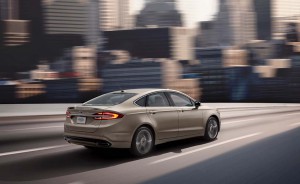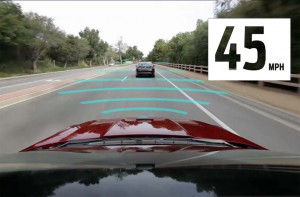Better late than never, or so Ford has apparently decided, as it becomes the latest in a fast-growing line-up of automakers to introduce adaptive cruise control. The technology will make its first appearance on a Ford-branded model with the launch of the updated 2017 Fusion sedan.
Adaptive cruise control – also known as active cruise control – uses a variety of sensors to monitor traffic ahead of a vehicle. In its most basic form, the technology will alternatively use throttle and brakes to alternately accelerate or slow to maintain a safe distance from the vehicle ahead. Ford will also give the 2017 Fusion the ability to come to a complete stop, if necessary.
“When testing this system, we traveled to cities like Chicago and Los Angeles, heading straight for the worst possible congestion,” said Scott Lindstrom, Ford driver-assist technologies manager. “It was important for us to test this system under conditions the average driver encounters every workday.”
Conventional cruise control allows a motorist to set a desired speed and maintain it without using the throttle. But such systems can’t operate in traffic where vehicles are constantly speeding up and slowing down – and occasionally coming to a complete stop.
Adaptive cruise control, or ACC, overcomes that problem by monitoring traffic flow with various camera, laser or radar sensors. The 2017 Ford Fusion uses both cameras, mounted next to the rearview mirror, and a grille-mounted radar unit, and is capable of adjusting to the flow of traffic every 50 milliseconds.
Drivers set their desired speed, as well as the distance they want to retain from the vehicle immediately ahead, that gap is automatically adjusted according to the vehicle’s speed. In heavy traffic conditions, the Fusion will be able to come to a complete stop, if necessary, and then start up when traffic resumes moving. If there is more than a three-second delay, the driver must either tap the throttle or the system’s “resume” button.
Ford claims the technology can “help take the edge off stressful traffic” conditions, noting that studies show the typical U.S. driver wastes at least an hour each week due to highway snarls.
(Ford, GM betting big on autonomous tech, mobility services. Click Here for more.)
The optional ACC package will introduce another feature to the 2017 Ford Fusion, Pre-Collision Assist with Pedestrian Detection. That system uses the same sensors as adaptive cruise, but here it is watching out for situations where the vehicle ahead might brake suddenly. If there’s a risk of a collision, Pre-Collision Assist first tries to alert the driver. If the motorist fails to react quickly, it will automatically apply the brakes in an effort to prevent a collision, or at least reduce its severity.
(Risky behavior behind the wheel running rampant, finds new study. Click Here for the story.)
The Ford system adds the ability to detect pedestrians, as well as motor vehicles, something considered particularly useful in urban driving.
A recent study by the Insurance Institute for Highway Safety found that auto-braking systems can reduce by as much as 40% the number of police-reported rear-end collisions.
Earlier this month, a consortium of 20 automakers, working with the National Highway Traffic Safety Administration, announced plans to make automatic emergency braking standard on virtually all vehicles sold in the U.S. by 2022. Ford was among those manufacturers.
(For more on plans to make auto-braking standard, Click Here.)



Ford has offered this optional feature on the Fusion as well as other vehicles since at least 2013.